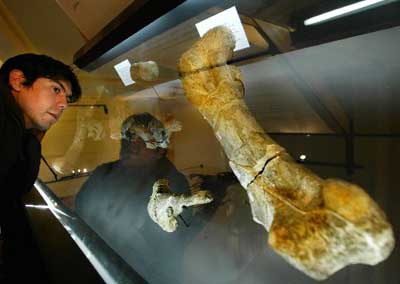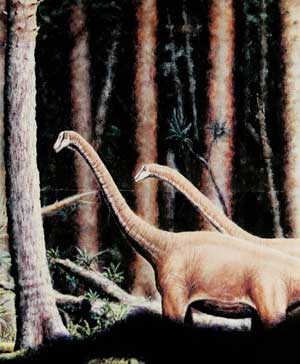|
|
|
|||||||||||||||||||||||||||||||||||||||||||||||||||||||||
|
简介(Brief Introduction) |
|
|
[A]2003年5月30日,在智利圣地亚哥自然科学博物馆,两位年轻的智利古生物学家,二十八岁的戴维‧鲁维拉尔(David Rubilar)与二十六岁的亚历山大‧巴尔加斯(Alexander Vargas)宣布,发现了一种新的恐龙。这种生活在7千万年前的蜥脚类恐龙不同于任何一种现今已知的恐龙种类。发现者命名这种恐龙为“ 智利多梅科龙”,以纪念19世纪智利科学家伊格纳西奥·多梅科。 数年前有一位地质学家在智利北部发现了一些恐龙的骨骼化石,戴维和亚历山大用这些化石拼成了新恐龙百分之四十的骨架,这是智利迄今为止所发现的最为完整的恐龙标本。 这种新恐龙属于恐龙大家庭中一个人类所陌生的巨龙家族,它有着长长的尾巴,脖子虽长却不灵活。人们曾在南美、马达加斯加和印度发现过巨龙的化石。目前,鲁维拉尔和巴尔加斯的发现尚未得到官方的认可。 [B]英文版: SANTIAGO, Chile (Reuters) - Two Chilean scientists said on Thursday they had discovered a new species of dinosaur, a long-necked plant eater that roamed the region 70 million years ago. Paleontologists David Rubilar, 28, and Alexander Vargas, 26, named their find "Domeykosaurus chilensis" after 19th Century Chilean scientist Ignacio Domeyko. They said it is unlike any other specimen found so far. They have assembled about 40 percent of the skeleton from fossils a geologist stumbled on several years ago in northern Chile, forming the most complete specimen ever found in Chile. The find has yet to be officially approved by the scientific community. " When we first figured out that this was something new, we visited fossil collections in Argentina and Brazil and we realized this creature has no name," Vargas told Reuters. The single skeleton belongs to a little-known family of dinosaurs called Titanosaurus, which have long tails and a long but inflexible neck. Titanosaurus fossils have been found in South America, Madagascar and India. Vargas and Rubilar, wearing scruffy jeans and grinning shyly next to a display of dinosaur bones in Santiago's natural history museum, said the domeykosaurus likely fed on araucaria, also known as monkey-puzzle trees, which are native to the area. The animal, which lived near the end of the dinosaur age in the Late Cretaceous period, measured about 25 feet long and its hips reached a height of about 6.5 feet. What sets the Chilean dinosaur apart from other species is that its extremities are slightly more elongated and thin, the scientists said. Rubilar and Vargas expect to publish their study in a Chilean geological journal later this year, a required step before their find is accepted as a new species. Renowned Argentine paleontologist Rodolfo Coria doubted their findings would be disputed. " It's quite likely this is a new species, I hope so," he told Reuters by telephone. "There are no (unique) Chilean dinosaurs (species to date) because usually the fossils are not well enough preserved to be able to determine if it is a new species or not," said the expert, who has personally discovered a dozen new species in the past decade in Argentine Patagonia. |
|
|
化石写真(Fossil Pic.) |
|
|
|
|
|
复原图(Restitute Pic.) |
|
|
|
|
本站复原图(保留版权)(Copyrighted Restitute Pic.) |
|


